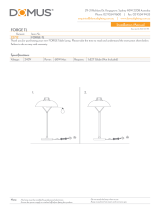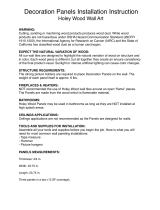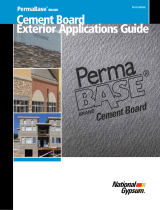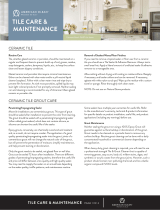
8x12 in
10x16 in
12x12 in
12x12 in
16x16 in
18x18 in
Beauty, easy to clean, durability and strength are the essential features when
buying a ceramic coating for walls and floors
Consider the warranty and quality of a product:
1. Selected raw materials (clays, glazes, etc.)
2. Control manufacturing process through latest equipment
3. Up-to-date technology
4. Wide range of designs, colors and sizes
5. Compliance with international standards of manufacturing
6. Extensive network of distributors nationwide
7. Customer service and free technical training
To ensure a perfect result, lasting beauty and durability have a qualified
operator use CELIMA adhesives and forges.
CELIMA adhesives prevent the need to soak the pieces or the surface to be
plated, which reduces drying time and allows quick gratification of the space
or room to be used.
Use RUBI tools for appropriate installation, such as cutters, rasps, spreaders,
and forgers.
WHICH ADHESIVE SHOULD I USE?
Select the adhesive according to the ceramic veneering and type of surface to
be coated.
GETTING READY TO PLACE THE VENEER:
1. Check the leveling, dryness and cleanliness of wall brackets and surface to
be coated.
2. All parts are properly leveled and aligned.
3. The veneer is dry before setting to prevent stains on the boards.
FOR NEW BUILDING
All adhesives prepared with approximately 250 ml of water per kg of
adhesive. The consumption varies according to the size of the pieces to
be plated and the surface to be coated (leveling).
Interior Gray Adhesive: for interior surfaces.
Interior Gray Premium Adhesive: for a better preview of work in interior
surfaces.
Interior White Super Adhesive: for interior surfaces, white body tile or
clear natural stones.
Exterior Gray Adhesive: exterior surfaces.
White Super Adhesive: for laying ceramic on ceramic
Porcelain white Adhesive: for placement of porcelain
Super Flexible White Adhesive: for placement of all types of coatings on
rigid or flexible surfaces (drywall, cement, etc.) and swimming pools.
Veneer starting with the walls and finishing with the flooring. Place the
pieces leaving a gap between them (see box) and additionally, consider
expansion joints forming 6x6, 8x8 m indoor panels and 3x3 to 4x4 m
outdoor panels, together with the level of subflooring or unfinished
flooring with a thickness of 8 mm 1 cm and a depth of 1 to 2 cm. Seal
joints between work pieces with forge and expansion joints with silicone
or polyurethane. Parts should never cover joints of construction.
YOU CAN USE:
YOU CAN USE:
RECOMMENDATIONS
Ceramic coatings are an option for use in walls and floors in homes,
commercial areas, dry and wet area, simple and sophisticated, indoor and
outdoor environments.
With a wide range of designs, colors and sizes that offer many advantages
over other coatings:
1. easy to clean and safe
2. Weather resistant
3. Versatile decoration
4. Hypoallergenic and non-flammable
For safety, do not install ceramic coatings with glossy finishes in outdoor
flooring because of possible damage due to humidity, rain or in areas of
heavy movement.
Protect your investment with mats, all types of surfaces can have abrasive
streaks or scratches (wood, marble) do not confuse resistance to heavy
movement with quality ceramic, this is just one of its features.
The CELIMA products are not resistant to temperatures below 0° degrees
centigrade; they are not anti-freeze.
CERAMIC WALL COATINGS
Made with a light, porous material which is a suitable characteristic for wall
fixtures. Installed with 3 mm joints to improve aesthetic results. These
coatings should not be used on floors.
FLOOR COATINGS
Single-fired tiling and enamels have appropriate characteristics for use on
floors.
They are strong against abrasion and have a higher scratch resistance than the
wall coverings
CERAMIC TILE FOR SWIMMING POOLS, TANKS AND CISTERNS:
Single-fired tiling and special enamels are suitable for installation on surfaces
immersed in water (flooring and background walls).
WHAT IS NECESSARY TO
KNOW BEFORE YOU DECIDE?
WHY CHOOSE CELIMA?
WHERE TO BE USED?
HOW TO INSTALL
CERAMIC VENEER?
Unfinished flooring / subflooring
CELIMA forges
Thickness = 8mm
Depth = 1 to 2 cm
Sealed with polyurethane
Joints between pieces
Expansion joints
CELIMA Adhesive
CELIMA ceramic
YIELDS:
INSTRUCTIONS FOR VENEERING
Floor / Wall
Floor / Wall
Floor / Wall
Pool
FOR OTHER SURFACES
CERAMIC IN CERAMIC:
ABOUT PARTITIONING
YIELDS:
1. Extend the adhesive on the surface to be coated.
In swimming pools, tanks, cisterns, large surfaces
and outdoor spaces, apply adhesive on the back
of ceramic also.
2. Scratch adhesive with jagged side of the rasp.
3. Place the parts and press down.
4. Allow to dry for 3 days before sealing the joints
with Celima Premium indoor forge or Celima
indoor/outdoor.
Perform a thorough cleaning and completely dry the surface, then veneer
with white, extra strength adhesive.
To improve adhesion the first acrylic application is recommended before
veneering.
Let dry 3 days and seal the joints with Premium CELIMA forge.
Use white, flexible adhesive or glue in CELIMA paste.
Install tile, allowing 3-5 days to dry, sealing the joints with Premium CELIMA
forges.
Approximately 3m² / 12 kg bucket of CELIMA adhesive paste.
Wall
Tile Size Minimum joint
Raspin tooth
*25 kg CELIMA powder adhesive.
m /bag*
Wall

Tile
Joint
Wall
8x12
10x16
12x12
12x12
16x16
18x18
Pool
Floor
IMPORTADOR: SERVICIOS HOME DEPOT, S. DE R.L. DE C.V.
RICARDO MARGAIN 605, SANTA ENGRACIA, SAN PEDRO GARZA GARCÍA, NUEVO LEÓN,
MÉXICO, C.P. 66267 Tel. 01 800 004 6633
Lea las instruciones antes de usar el producto.
Garantía impresa en el manual no válida para México
Belén Natural
Forget the stains and dirt in the joints, use Celima forge for indoor or
CELIMA premium forge for indoors, outdoors and damp areas (bathrooms
and kitchens).
Once the veneering is dry, clean the joints. No need to wet the surface before
setting. The Celima Forge can be prepared with approximately 250 ml of
water per kg of forge.
The surface for plating a pool must be dry:
Waterproof concrete structure: minimum 7 days.
Unfinished surface that is not waterproof: minimum 3 days.
Ceramics for pools are more resistant to bending, have lower water
absorption and special enamel that resists permanent chemicals used in water
treatment.
CELIMA plus Forge pool has greater resistance to moisture and chemicals
that exist in pools.
Prepare super flexible white adhesive and extend leaving a gap of 3-4 mm
between each of them.
Make expansion joints 8 mm and 1 to 2 cm deep every 5 m (separately) in
length.
For proper adhesion, the back of the pieces must be filled with adhesive.
After 03 days, seal the joints between parts with CELIMA Pool plus Forge
Seal expansion joints and contours of recirculation equipment (skimmers,
suction grilles, return valves) and lighting (underwater headlights with
polyurethane).
DEEP CLEAN BEFORE REMODELING: Wash the surface with
muriatic acid diluted with water (1:10), scrub with brush and rinse. Wash with
water and mild detergent, rinse thoroughly and let dry.
FINAL CLEANING AT THE ENDOF THE WORK: Wash and
remove cement with t CELIMA No.1 or muriatic acid diluted with water
(1:10) scrub with brush and rinse
DAILY MAINTENANCE: wash with universal cleaner CELIMA No. 10
or with neutral detergent and water. Do not use wax.
HOW TO SEAL JOINTS?
HOW TO VENEER A
SWIMMING POOL?
HOW TO MAINTAIN A
SWIMMING POOL
HOW TO CLEAN?
INSTRUCTIONS FOR SETTING:
YIELD:
VENEER
SETTING
PRIOR TO USE:
MAINTENANCE
MONITOR THE WATER
CONSEQUENCES OF IMPROPER MAINTENANCE
The day after forging, wash veneering with Celima No. 1 cement remover
and Celima No. 10 universal cleaner.
Let dry 7 days before fill the pool with water.
Control of chlorine and pH is performed to remove bacteria. In regards to
water treatment the following should be taken into account:
The recirculation and permanent water filtration reduces the formation of
tartar and deterioration of ceramics
Perform periodic inspections and forge damaged joints to prevent water
seepage.
Perform all work in a maximum of 15 or 20 days
Do not leave the pool without water for long periods of time. The
difference of pressure (filled pool versus empty pool) deteriorates ceramic.
USE AND CARE
MANUAL - CELIMA
CERAMIC TILES
WHERE TO USE?
HOW TO
CHOOSE?
HOW?
- INSTAL
- SEAL
- CLEAN
1. Fill the joints with rubber forger; allow it to
dry 20 min.
18x18
12x12
2. Clean with damp sponge and allow drying.
Wipe off dust with dry cloth.
Calcium carbonate (Hardness CaCO3) => Leading to damage of the forge,
water filtration and deterioration of ceramics.
Alkalinity=> Produces pores in the ceramic glaze.
Chlorine=> Salty tasting water that does not cause harm.
Sulfates=> Leading to forge and filtration damage.
pH
Residual chlorine
Hardness CaCO3
Alkalinity
Chlorides
Sulfates
Acceptable between 6.5 and 8.5
Acceptable with less than 2.0 mg/l
Acceptable between 75 and 250 ppm
Recommendable between 80 and 150 ppm
Acceptable between 75 and 250 ppm
Acceptable with less than 200 ppm
Acceptable with less than 150 ppm
Floor and wall - Pool Tiles
Floor - Exterior Tiles
Adhesive for veneer
Adhesive Joints
Forge for sealing joints
Approximately 1 kg of Celima Forge per m
18x18
18x18
-
 1
1
-
 2
2
Ask a question and I''ll find the answer in the document
Finding information in a document is now easier with AI
Related papers
Other documents
-
Builders Choice C16010208X User manual
-
Merola Tile FGA6KRDS Specification
-
 DOMUS LIGHTING FORGE Table Lamp Installation guide
DOMUS LIGHTING FORGE Table Lamp Installation guide
-
Crossco AM206-4 Operating instructions
-
 Easy Planking 11145 Installation guide
Easy Planking 11145 Installation guide
-
daltile K775441P1 User manual
-
Mapei 3BT003591 Installation guide
-
 Permabase 50005394 User manual
Permabase 50005394 User manual
-
 American Olean CG1712121P6 User manual
American Olean CG1712121P6 User manual
-
Ekena Millwork T200NRMO Installation guide





